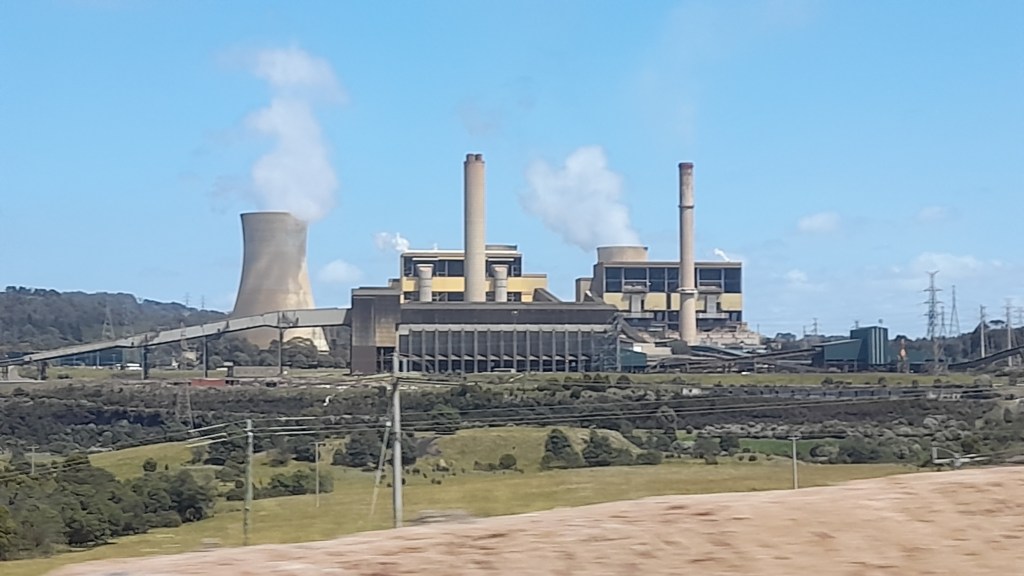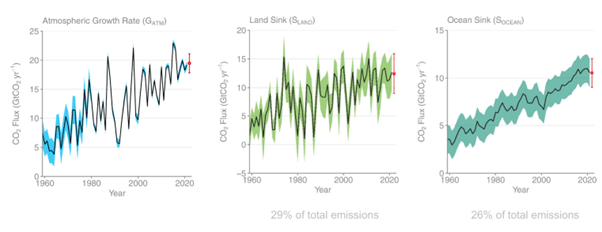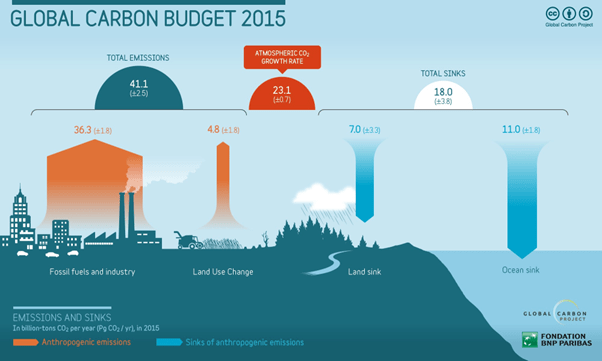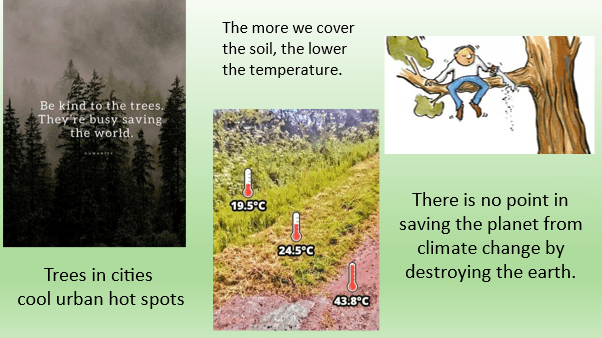Burning coal to produce electricity is a terrible waste when coal has so many other important uses. At this time, the energy from it is still essential for the manufacture of wind turbines, transmission lines and solar panels.
It is not always realised that coal is needed:
as a source of essential ingredients for the manufacture of many dyes, pharmaceuticals, explosives, perfumes, plastics, paints and photographic materials; and
to produce the very high temperatures needed to manufacture steel, cement, aluminium, bricks, glass and some metals and chemicals.
Latrobe Valley, Victoria, Australia
A few weeks ago, David and I attended a conference in the Latrobe Valley held by CRC TiME called “Bridging Diverse Interests”. https://crctime.com.au/ When a coal mine or any mine is closed down, a complex rehabilitation process follows. Delegates at the conference had the opportunity to visit both Hazelwood and Yallourn brown coal mine and power station sites.

The Latrobe Valley mines are large, close together, close to local communities and infrastructure. The power stations have a small footprint on each mine site. Mine Land Rehabilitation Authority
Hazelwood Power Station and its associated coal mine stopped operating in 2017. The owner, French company Engie plans to spend a billion dollars rehabilitating the mine site by filling the giant mining pit with water. The volume needed will be greater than that of Sydney Harbour. The plan is still under discussion by many stakeholders. We heard from some of the community groups about their hopes for the site. The closure has already had a big impact on local townships and the staff who lost their jobs. Three years after the closure, a survey found these highly skilled workers were still only earning an average of 50 % of the income received prior to the closure. Questions remain about the feasibility of the rehabilitation plan. Enough water may not be available and contaminant levels in the ash have been highlighted by a green group as a possible long-term issue.

Yallourn Power Station – photo by David Jones
Yallourn is scheduled to close in 2028. River water, currently used by the power station for cooling, will be used to fill the pit. It will take decades. The ground is soft, like the brown coal itself, and collapse of the sides of the pit must be carefully avoided. The ash is low in contaminants and should not pose a problem with water quality. Often there is disparity between the requirements of the regulators, the local community, the First Nations People and the technical and economic considerations of the miners. Just because the community desires a certain outcome, it may not be technically possible and safe.

Yallourn Coal Mine: the coal seam is 80 metres thick and can be seen in the background. Lines of trees have been planted in the bottom of the pit. Photo by David Jones
The third power station, Loy Yang, and its associated mine is also scheduled for closure in 2035 bu.
What is the future of the Latrobe Valley? Will it be left with lots of orphaned transmission lines and closed businesses, medical facilities and schools? This will happen unless viable solutions developed in consultation with regional communities are identified and implemented. It has been suggested in other forums that coal-fired power stations could be replaced by nuclear power stations thus making use of these industrial sites and transmission infrastructure, while providing similar jobs for the already skilled workforce. Participants I spoke to from other places in Australia were pro-nuclear but locals were wary. The social licence was not there because of a historical distrust of Government processes. Technically the sites would need to be evaluated for ground stability.
A central theme of the conference was that First Nations People should be properly and fully involved early in the process of planning mine closure.
Mining Rehabilitation
The NT Government is working in partnership with the Australian Government and Traditional Owners to rehabilitate the former Rum Jungle Uranium Mine Site. Early rehabilitation work was undertaken in the 80s and the traditional owner groups were not involved in the process. The site does not meet today’s standards. The current project will remove a major impediment to the site’s return in good order to the Kungarakan and Warai people.
The inspirational project leader, Jackie Hartnett of NT Government, gave an insightful presentation on the project. She has worked hard to find solutions acceptable to all the traditional owners with the tremendous assistance of Gowan Bush, the community manager. Jackie is undertaking the rehabilitation work by training and employing the local people. As a mother myself, I noted that a female birthing site will be restored by sending a stream back to its original path. Nobody knows whether this will be fully successful but the women are delighted.
My husband Dr. David Jones gave a technical presentation on the Rum Jungle Rehabilitation Project on behalf of NT Government as an Industry Fellow of UQ Sustainable Minerals Institute. https://smi.uq.edu.au/ It is noteworthy that the main source of environmental problems on the site is acid mine drainage with copper levels causing the issues rather than uranium or radioactivity.
The presentations were praised by the head of INAP as a new paradigm for mine rehabilitation. INAP stands for International Network for Acid Prevention and is an organisation set up by the mining industry itself to find, promulgate, and use the best methods of preventing and coping with acid and metalliferous drainage (AMD). AMD can occur with any type of mine depending on the geology of the area.
“AMD is one of the most serious and potentially enduring environmental problems for the mining industry. Left unchecked, it can result in such long-term water quality impacts that could well be this industry’s most harmful legacy.” https://www.inap.com.au/
How do we use coal apart from making electricity?
China uses the most coal in the world with the U.S and India in a distant second place. The U.S. has 2/3 of the world’s known supply. Australia only mines 4% of the world’s coal but we export 80% of it, making Australia the second largest coal exporter in the world. We export low sulfur bituminous coal for energy production used to manufacture “renewable energy infrastructure” and the highly valued and rarer metallurgical coal, also known as coking coal, to produce steel and cement and critical metals and other ingredients.
There are 4 main types of coal and the world still has 400 years’ supply at our current rate of use.
Peat is the youngest form of coal. It is low quality and is burnt for fuel and heating on a small scale or even used as a soil conditioner by gardeners.
Lignite or Brown Coal is about 150 million years old. It has about 50% carbon and low sulfur content. It is used to produce electricity but is relatively inefficient because it has a high water content and must be dried first. This results in the highest amount of carbon dioxide per unit of electricity produced. The Latrobe Valley Coal mines produce brown coal.
Bituminous Coal has a high carbon content ( 50-80%) but often has a high sulfur content. It is the most plentiful type of coal in the U.S. and is about 300 million years old. Sub-bituminous coal has a lower sulfur content and carbon content and is a little younger. Sub-bituminous coal is the preferred form for power plants.
Anthracite, often known as Metallurgical Coal. is the highest quality of coal with a high carbon (95%) but low sulfur content and is about 500 million years old. Australia has large supplies of this form of coal which is valued for all its uses apart from electricity production. There is limited supply worldwide and it almost a sin to burn it up to produce electricity. It is the hardest and cleanest burning coal.
Anthracite is valuable
· as a source of essential ingredients for the manufacture of many dyes, pharmaceuticals, explosives, perfumes, plastics, paints and photographic materials; and
· to produce the very high temperatures needed to produce steel, cement, aluminium, bricks, glass and some metals and chemicals. The carbon in anthracite forms part of the matrix of steel.
· It is used in smelting operations to release metals such as lithium from their ores – a very energy intensive process.
Coal pyrolysis, or destructive distillation, is an old technology that started on a commercial scale during the industrial revolution. When coal is burnt without the presence of oxygen, three main products result: coal gas; coal tar; and coke.
Coal tar is the actual source of the essential ingredients to make many products such as some dyes, pharmaceuticals, explosives, perfumes, plastics, paints and photographic materials.
Various forms of gas can substitute for some of coal’s uses. It can act to stabilise the electricity grid much more efficiently and produces far less carbon dioxide per unit of electricity produced.
Hydrogen and some types of nuclear power may be able replace the high temperatures produced by coal and gas as the technologies mature. The production and use of hydrogen is a very energy inefficient.
What about Oil? Why Can’t We Stop It’s Use Tomorrow?
Nearly half of a barrel of oil is separated as gasoline/petrol. Slightly more than half is used as feedstock in the manufacture of more than 6000 products. I found a list of 144 of them. Just taking one item, combs. Can you imagine making combs the old way from turtle shell or bone? The world’s population has grown so much it is hard to imagine doing without many of the items listed below. And what do we plan to do with all the waste stream of petrol in the future?
Can we face a world without antibiotics and anaesthetics or hospitals? Imagine there are no building materials except wood or mud or straw, no fertilizers or pillows or candles or ink and no forests or wildlife. We still need coal and oil to produce electric cars.
We have a lot of thinking and planning to do. Imagine a world without any:
| Solvents | Diesel fuel | Motor Oil | Bearing Grease |
| Ink | Floor Wax | Ballpoint Pens | Football Cleats |
| Upholstery | Sweaters | Boats | Insecticides |
| Bicycle Tires | Sports Car Bodies | Nail Polish | Fishing lures |
| Dresses | Tyres | Golf Bags | Perfumes |
| Cassettes | Dishwasher parts | Tool Boxes | Shoe Polish |
| Motorcycle Helmet | Caulking | Petroleum Jelly | Transparent Tape |
| CD Player | Faucet Washers | Antiseptics | Clothesline |
| Curtains | Food Preservatives | Basketballs | Soap |
| Vitamin Capsules | Antihistamines | Purses | Shoes |
| Dashboards | Cortisone | Deodorant | Shoelace Aglets |
| Putty | Dyes | Panty Hose | Refrigerant |
| Percolators | Life Jackets | Rubbing Alcohol | Linings |
| Skis | TV Cabinets | Shag Rugs | Electrician’s Tape |
| Tool Racks | Car Battery Cases | Epoxy | Paint |
| Mops | Slacks | Insect Repellent | Oil Filters |
| Umbrellas | Yarn | Fertilizers | Hair Colouring |
| Roofing | Toilet Seats | Fishing Rods | Lipstick |
| Denture Adhesive | Linoleum | Ice Cube Trays | Synthetic Rubber |
| Speakers | Plastic Wood | Electric Blankets | Glycerine |
| Tennis Rackets | Rubber Cement | Fishing Boots | Dice |
| Nylon Rope | Candles | Trash Bags | House Paint |
| Water Pipes | Hand Lotion | Roller Skates | Surf Boards |
| Shampoo | Wheels | Paint Rollers | Shower Curtains |
| Guitar Strings | Luggage | Aspirin | Safety Glasses |
| Antifreeze | Football Helmets | Awnings | Eyeglasses |
| Clothes | Toothbrushes | Ice Chests | Footballs |
| Combs | CD’s & DVD’s | Paint Brushes | Detergents |
| Vaporizers | Balloons | Sun Glasses | Tents |
| Heart Valves | Crayons | Parachutes | Telephones |
| Enamel | Pillows | Dishes | Cameras |
| Anaesthetics | Artificial Turf | Artificial limbs | Bandages |
| Dentures | Model Cars | Folding Doors | Hair Curlers |
| Cold cream | Movie film | Contact lenses | Drinking Cups |
| Fan Belts | Car Enamel | Shaving Cream | Ammonia |
| Refrigerators | Golf Balls | Toothpaste | Gasoline |











